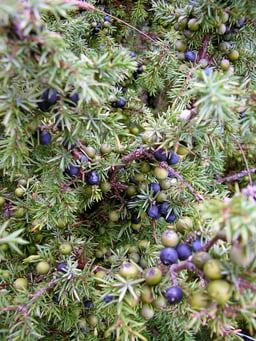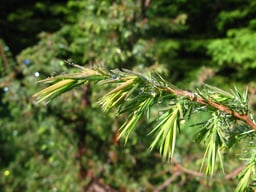Juniperus communis
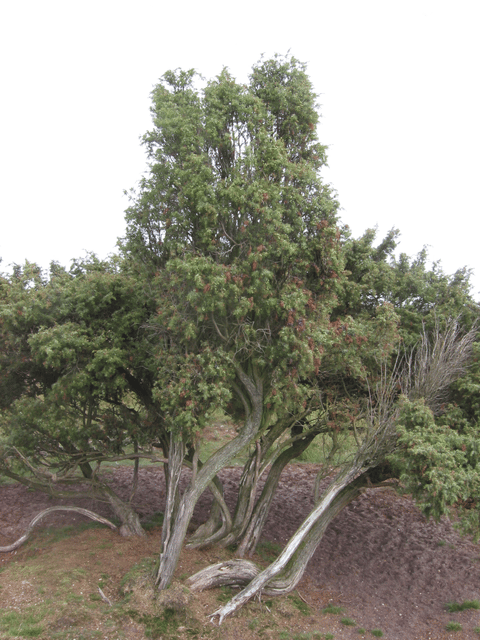
Juniperus communis

| Juniperus communis | |
|---|---|
| Juniperus communis subsp. communis in the Netherlands | |
Conservation status | |
| Scientific classification | |
| Kingdom: | Plantae |
| Division: | Pinophyta |
| Class: | Pinopsida |
| Order: | Pinales |
| Family: | Cupressaceae |
| Genus: | Juniperus |
| Section: | *Juniperussect.Juniperus* |
| Subsection: | Juniperus subsect. Juniperus |
| Species: | J. communis |
| Binomial name | |
| Juniperus communis | |
 | |
| Natural range world-wide | |
 | |
| Natural range in North America | |
Juniperus communis, the common juniper, is a species of conifer in the genus Juniperus, in the family Cupressaceae. It has the largest geographical range of any woody plant, with a circumpolar distribution throughout the cool temperate Northern Hemisphere from the Arctic south in mountains to around 30°N latitude in North America, Europe and Asia. Relict populations can be found in the Atlas Mountains of Africa.
| Juniperus communis | |
|---|---|
| Juniperus communis subsp. communis in the Netherlands | |
Conservation status | |
| Scientific classification | |
| Kingdom: | Plantae |
| Division: | Pinophyta |
| Class: | Pinopsida |
| Order: | Pinales |
| Family: | Cupressaceae |
| Genus: | Juniperus |
| Section: | *Juniperussect.Juniperus* |
| Subsection: | Juniperus subsect. Juniperus |
| Species: | J. communis |
| Binomial name | |
| Juniperus communis | |
 | |
| Natural range world-wide | |
 | |
| Natural range in North America | |
Description
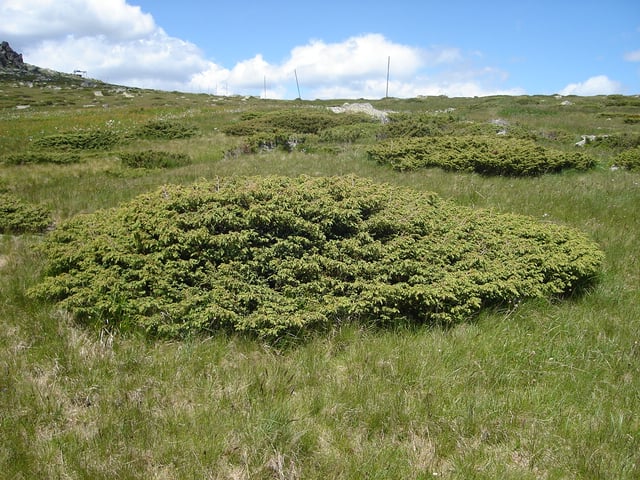
Prostrate specimens of Juniperus communis subsp. alpina, in Vitosha, Bulgaria
Juniperus communis is a small coniferous evergreen tree or shrub, very variable in form, ranging from 10 m (33 ft)—rarely 16 m (52 ft)—tall to a low, often prostrate spreading shrub in exposed locations. It has needle-like leaves in whorls of three; the leaves are green, with a single white stomatal band on the inner surface. It never attains adult foliage.[2] [] It is dioecious, with male and female cones, which are wind pollinated, on separate plants.
The fruit are berry-like cones, initially green, ripening in 18 months to purple-black with a blue waxy coating; they are spherical, 4–12 mm (0.16–0.47 in) diameter, and usually have three (occasionally six) fleshy fused scales, each scale with a single seed. The seeds are dispersed when birds eat the cones, digesting the fleshy scales and passing the hard, unwinged seeds in their droppings. The male cones are yellow, 2–3 mm (0.079–0.118 in) long, and fall soon after shedding their pollen in March–April.[3][4][5]
Subspecies
subsp. communis – Common juniper. Usually an erect shrub or small tree; leaves long, 8–20(–27) mm; cones small, 5–8 mm, usually shorter than the leaves; found at low to moderate altitude in temperate climates. subsp. communis var. communis – Europe, most of northern Asia subsp. communis var. depressa Pursh – North America, Sierra Nevada in California subsp. communis var. hemisphaerica (J.Presl & C.Presl) Parl. – Mediterranean mountains subsp. communis var. nipponica (Maxim.) E.H.Wilson – Japan (status uncertain, often treated as J. rigida var. nipponica)
subsp. alpina (Suter) Čelak. – alpine juniper (syn. J. c. subsp. nana, J. c. var. saxatilis Pallas, J. sibirica Burgsd.). Usually a prostrate ground-hugging shrub; leaves short, 3–8 mm; cones often larger, 7–12 mm, usually longer than the leaves; found in subarctic areas and high altitude alpine zones in temperate areas. subsp. alpina var. alpina – Greenland, Europe and Asia subsp. alpina var. megistocarpa Fernald & H.St.John – Eastern Canada (doubtfully distinct from var. alpina) subsp. alpina var. jackii Rehder – Western North America (doubtfully distinct from var. alpina)
Some botanists treat subsp. alpina at the lower rank of variety, in which case the correct name is Juniperus communis var. saxatilis Pallas,[4] though the name Juniperus communis var. montana is also occasionally cited; others, primarily in eastern Europe and Russia, sometimes treat it as a distinct species J. sibirica Burgsd. (syn. J. nana Willd., J. alpina S.F.Gray).[11]
Juniperus communis is one of Ireland's longest established plants.[12]
Chemistry
The juniper berry oil is composed largely of monoterpene hydrocarbons such as α-pinene, myrcene, sabinene, limonene and β-pinene.[13]
Uses
Cultivation
Crafts
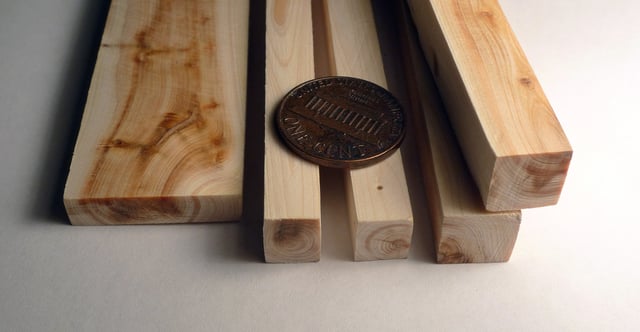
Juniperus communis wood pieces, with a U.S. penny for scale, showing the narrow growth rings of the species.
It is too small to have any general lumber usage. In Scandinavia, however, juniper wood is used for making containers for storing small quantities of dairy products such as butter and cheese, and also for making wooden butter knives. It was also frequently used for trenails in wooden shipbuilding by shipwrights for its tough properties.
In Estonia juniper wood is valued for its long lasting and pleasant aroma, very decorative natural structure of wood (growth rings) as well as good physical properties of wood due to slow growth rate of juniper and resulting dense and strong wood. Various decorative items (often eating utensils) are common in most Estonian handicraft shops and households.
According to the old tradition, on Easter Monday Kashubian (Northern Poland) boys chase girls whipping their legs gently with juniper twigs. This is to bring good fortune in love to the chased girls.
Juniper wood, especially burl wood, is frequently used to make knife handles for French pocketknives such as the Laguiole.
Culinary
Its astringent blue-black seed cones, commonly known as "juniper berries", are too bitter to eat raw and are usually sold dried and used to flavour meats, sauces, and stuffings. They are generally crushed before use to release their flavour. Since juniper berries have a strong taste, they should be used sparingly. They are generally used to enhance meat with a strong flavour, such as game, including game birds, or tongue.
The cones are used to flavour certain beers and gin (the word "gin" derives from an Old French word meaning "juniper").[19] In Finland, juniper is used as a key ingredient in making sahti, a traditional Finnish ale. Also the Slovak alcoholic beverage Borovička and Dutch Jenever are flavoured with juniper berry or its extract.
Juniper is used in the traditional farmhouse ales of Norway,[20] Sweden,[21] Finland,[22] Estonia, and Latvia. In Norway, the beer is brewed with juniper infusion instead of water, while in the other countries the juniper twigs are mainly used in the mash, as filters to prevent the crushed malts from clogging the outlet of the mashing tun. The use of juniper in farmhouse brewing has been common in much of northern Europe, seemingly for a very long time.[23]


